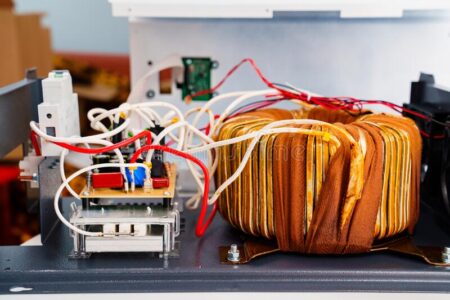Using a voltage stabilizer to protect your electrical devices like air conditioners, refrigerators, LED TVs, etc., is a personal choice. Besides, much depends on the power supply quality in your area.
If you live in a city like Mumbai or Delhi, voltage fluctuations are almost non-existent. But it is common for people living in Tier II cities and even metros like Chennai to experience voltage fluctuations regularly. So being safe is better than regretting your decision later.
We now ask, “Does our inverter AC need a voltage stabilizer?” But first, let us discuss how an inverter AC differs from a standard AC.
Inverter AC vs Normal AC
The traditional AC compressor works at a single speed (full speed) to cool the room. As the temperature drops to the set level, the compressor switches off, allowing the fan to maintain cooling. Subsequently, it restarts when the temperature rises above the specific threshold level.
In contrast, the inverter AC compressor does not switch off at all. Instead, it works at variable speeds to maintain optimal cooling. Since the speed varies, it consumes less power. Besides, today’s highly-advanced inverter AC compressors can operate at varying capacities according to room temperature conditions.
A 1.5-ton inverter AC can work as a 0.80-ton AC, and 1.8-ton AC whenever required. Therefore, it comes equipped with a function that allows the appliance to work at varying voltages. Thus, is a voltage stabilizer required for an inverter AC under such circumstances?
Need for a voltage stabilizer
The standard operating voltage in India is between 220 and 250 volts. So, if the input voltage fluctuates beyond these levels, it can damage the PCB in the AC. Therefore, we use external voltage stabilizers that ensure the AC continuously receives 230V current, irrespective of the input voltage.
But people can argue that inverter AC compressors are designed to handle voltage fluctuations. Unfortunately, the fact is otherwise. Inverter AC compressors are programmed to function at varying voltages to work at different capacities, But that does not entail they can handle voltage fluctuations.
Therefore, AC manufacturers like LG, Samsung, Daikin, and others mention whether their products feature an internal stabilizer or offer stabilizer-free operations. We have highlighted the difference between these two terms in one of our earlier blogs.
Stabilizer-free Operations
All Daikin non-inverter ACs have compressors that can handle a wide voltage range from 160V to 264V. Therefore, the AC compressor can work comfortably if the input voltage is in this range. But, if the voltage fluctuates beyond these levels, it can damage the PCB, leading to expensive repairs. But the safety feature shuts off the power to the AC.
In-built Stabilizers
Almost all Daikin inverter ACs feature an inbuilt stabilizer that stabilizes the input voltage and maintains it at 240V. These AC compressors can work in an extensive range from 160V to 264V. The difference is that the inbuilt stabilizer maintains a constant voltage supply to the AC. In addition, these ACs have a safety feature that switches off the power to the AC.
New Stabilizer Mode
The latest Daikin JTKJ series inverter ACs feature inbuilt stabilizers that can work in an input voltage range of 130V to 265V.
Samsung S-UTR Compressor
The latest Samsung inverter ACs feature the S-UTR compressor that works similarly to the latest Daikin compressors. It switches off the power supply to the AC if the input voltage is outside the specified range. Thus, this feature protects your AC from damage.
The Inference
From the above arguments, we can deduce that if the AC does not feature an inbuilt stabilizer or have an S-UTR compressor, it requires an external voltage stabilizer. However, it is safe even for ACs equipped with these features because the external voltage stabilizer can handle input voltages in a more significant range from 90V to 300V. Therefore, if you care for your expensive inverter ACs, it makes sense to use an external voltage stabilizer and protect the AC’s components from damage.
The Advantages of an External Voltage Stabilizer
- The external voltage stabilizer can work in a more extensive input voltage range of 90V to 300V. So, it can supplement the power and safety requirements of inverter ACs that come with inbuilt stabilizers or S-UTR compressors.
- Since the external voltage stabilizer functions at a variable input voltage range, it protects the AC’s PCB from damage. PCBs are expensive components. Even manufacturers offering warranties on PCBs do not provide free replacement the second time within the warranty period.
- The external voltage stabilizer absorbs excessive voltage shocks, especially during voltage surges, and protects the AC components.
- An external voltage stabilizer saves current by maintaining the input voltage to the AC at constant levels.
Final Take
An external voltage stabilizer is a utility device that protects your AC components from damage. While the latest inverter compressor ACs can work in an extensive voltage range, an external voltage stabilizer can supplement their functioning by providing support.


